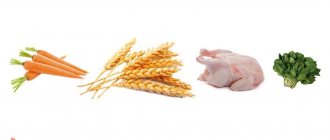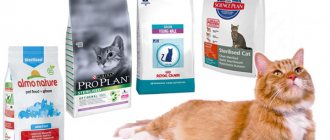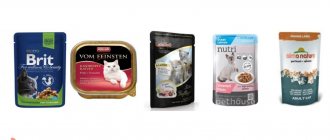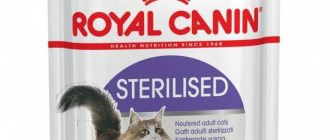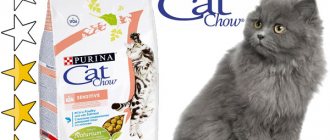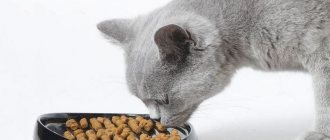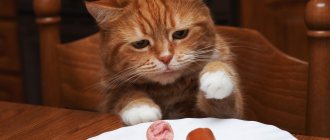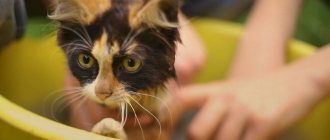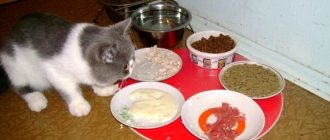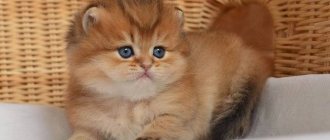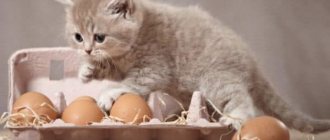What will you learn from the article?
- The best foods for sterilized cats: Optimeal Cat Adult Sterilized Turkey and Optimeal Cat Adult Sterilized Beef&Sorghum
- Hill's Science Plan Feline Sterilized Cat Young Adult
- Eukanuba Adult Sterilized/Weight Control
- Almo Nature Holistic Adult Cat Adult Beef and Rice
- Bosch Sanabelle STERILIZED
- Royal Canin Neutered Young Female
- 1st Choice Sterilized
After sterilization or castration of a cat, a complete hormonal change in the body occurs. The animal stops demanding the attention of the mustachioed gentlemen, becomes calmer, but, alas, can quickly gain excess weight.
Excess body weight primarily negatively affects the cardiovascular system, provokes the development of urolithiasis, and causes deterioration in the condition of the coat and mucous membranes.
It is advisable to decide what to feed a cat after sterilization before the operation.
It is very important not to overfeed the animal and provide it with complete nutritious food with vitamins, micro- and macroelements.
Ready-made dry food, which you can buy in the store, will fully provide your pet with all the necessary substances, improve its health, and prevent many diseases. Of course, if you feed her with high-quality premium, super-premium or holistic food, and not with cheap surrogates, the advertisements of which can often be seen on TV.
Natural nutrition
Sterilization is an operation to remove the ovaries. After the procedure, the production of sex hormones ceases, which entails physiological and behavioral changes in the cat with undesirable consequences:
- appetite increases;
- motor activity decreases;
- metabolism slows down;
- the number of urinations decreases.
The first three factors lead to weight gain and obesity, the last - stagnation of urine, the formation of sand and stones. The type of food does not change after sterilization, but it is better to review the “menu”. Read more: How to feed obese cats.
You might be interested in:
- What to feed a pregnant cat
Sterilization is not to blame
Sterilization is the right way to prolong a pet’s life and improve its quality. But health largely depends on proper feeding. No matter how “cute” a chubby cat may look, don’t forget that this is the beginning of a serious problem. Such an animal will not be able to lead an active lifestyle and play, and runs the risk of becoming obese, developing diabetes, and problems with joints, heart, kidneys, and liver.
It is not the food or the operation itself that is to blame for obesity - the responsibility lies primarily with the owners, so it is better not to neglect the advice of our veterinarians on how to properly feed a sterilized cat.
Feed your cat correctly after castration, and you will not notice any changes in her behavior or appearance. She will be as active, playful and healthy as before.
Healthy foods
Half of the diet is made up of proteins, the rest is made up of carbohydrates with fiber and fats.
It includes the following “dishes”:
Poultry, rabbit, beef. This is the basis of nutrition, it is given daily in boiled form, raw food is pre-frozen for 5 - 6 days. Before feeding, cut into pieces. Minced meat is allowed if you prepare it yourself; store-bought stuffing is too fatty. Fresh meat is not fed to avoid infection with helminths.
By-products: lung, kidneys, liver. They contain nutrients that are not found in muscle fibers; they are also frozen or boiled and included in the diet 2 times a week.
Meat broths. It is useful to accustom sterilized pets to this dish: they need an increased amount of liquid, but they are reluctant to drink water.
Vegetables: zucchini, carrots, pumpkin, cabbage. The boiled product is crushed into puree, the raw product is grated. If the pet refuses vegetables in their pure form, they are mixed with chopped meat or broth.
Fermented milk products up to 10% fat. Ryazhenka, sour cream, kefir, yogurt without fillers, and cheese are suitable.
Porridge: rice, barley, wheat, buckwheat. A teaspoon is added to meat or offal. If the animal refuses, then it is replaced with bran.
Vegetable oil, butter. Add 2-5 drops to food to maintain normal coat condition and improve stomach function.
It is useful to sprout greens from wheat grains, oats, or buy ready-made grass at a pet store. Vitamin and mineral supplements are given only on the recommendation of a veterinarian.
Do I need to give a neutered cat additional supplements?
In the absence of specific health problems, cats do not need additional supplements. On the contrary, an excess of nutrients can cause harm. For example, excess calcium causes urolithiasis, weakened immunity and blood clotting disorders. If your pet is fed dry food, it is best to avoid using supplements since the diet already contains all the necessary vitamins and minerals. Drugs are given only when necessary and after consultation with a veterinarian.
There are special supplements for the prevention of urolithiasis, but they are used only if there is a risk of stone formation
Unwanted Products
Excessive amounts of magnesium and phosphorus provoke urolithiasis, so food with these microelements is limited. Useless and harmful “dishes” should not be eaten by any cat.
After sterilization, exclude from the diet:
- pollock, cod, and other types of fish are fed boiled no more than 2 times a month;
- sugar, sweets;
- pork;
- legumes;
- oatmeal, semolina;
- smoked meats and sausages;
- potato;
- garlic and onion;
- raw eggs.
Salt also provokes urolithiasis, so do not add salt to dishes.
Feeding regimen and norms
After sterilization, the cat eats more and moves less; the amount of food eaten must be controlled. It is better to find out the exact weight before surgery, and then periodically weigh the pet and make sure that the numbers do not increase.
The daily norm is calculated based on the size of the animal: 30 - 50 g of food per 1 kg of body weight or up to 5% of the total weight. The main indicator of a correctly calculated norm is stable weight. If it increases, the animal overeats; if it decreases, there is not enough food.
According to the observations of doctors, the average cat requires 140–250 g of food per day, of which:
- 70 – 120 g meat;
- 30 – 60 g of lactic acid products;
- 35 – 50 g vegetables;
- 10 – 20 g of cereals.
The pet is fed at certain times twice a day; food cannot be given on demand. When signs of obesity appear, when the ribs cannot be felt, they switch to fractional meals. The number of meals is increased to 4–5 times, portions are reduced, and the daily intake is divided into parts.
Place for eating
While eating, the cat should not be disturbed by anything or anyone - this will help avoid digestive problems.
It is also important to choose a suitable place for feeding your pet: quiet and calm enough so that no one disturbs it, in order to avoid absorbing food too quickly (in this case, there is a high probability that the cat will vomit the food). The place should also be clean, at a fairly large distance from the tray. You can use a special mat on which you will place the bowl. If there are many animals in the house, the bowls should be at a sufficient distance from each other. Well, if the pets don’t get along with each other, their feeding places need to be separated altogether. Feeding times should always be the same.
Ready food
It is better for the owner to weigh the financial possibilities in advance and decide on the brand. It is unacceptable to give holistics first, and then a week later switch to Whiskas from the nearest supermarket.
Veterinarians recommend not paying attention to advertising slogans, but carefully reading the description on the packaging.
High-quality food has the following characteristics:
- The components are listed in detail in descending order, with meat coming first.
- The names of the ingredients can be understood by a person without special education.
- There are no dyes or flavoring additives; the shorter the list of ingredients, the better.
The daily dosage is indicated on the package; the lower it is, the more nutritious the product. This is important for dry food: cats do not like water, and they need 3 times more water than what they eat.
The composition contains L-carnitine and L-lysine: the first component accelerates metabolism, stimulates fat burning, the second maintains muscle mass.
You can make sure that your choice is correct after 2–3 weeks by looking at the pet’s appearance and well-being. The food is suitable if she has a smooth and shiny coat, normal digestion, regular bowel movements, and a moderately well-fed body.
How to properly feed a cat after sterilization when gaining weight: changing the diet
The first thing you need to do when gaining weight is to reduce your calorie intake through the following options:
- reduce the amount of carbohydrates as much as possible - look at the composition of the food and replace the product if it contains a lot of grains, potatoes or legumes (the less grains and starchy foods the cat gets from the food, the better);
- reduction in fat levels - look at the fat content in the guaranteed analysis; for cats that are prone to obesity or are overweight, it is advisable that its level should not exceed 15%;
- ensuring sufficient mobility - play with your cat a lot, give her interesting toys so that she can move as much as possible.
It should be noted that reducing calorie content does not mean reducing the quality of feed. It is extremely important for a cat to receive high-quality sources of fat and protein, so diets in which full-fledged animal fat is replaced with vegetable oil, and meat with sources of vegetable protein, are not suitable for her in any case.
Review of brands
Economy class food is not suitable: these are Friskas , NashaMarka , Kitikat , Whiskas . They contain 0.5% proteins, a lot of useless carbohydrates, and chemical flavor enhancers.
Manufacturers of premium and super premium products produce special lines for sterilized and neutered animals marked Sterilized . They are characterized by a reduced content of fat, phosphorus and magnesium.
Here are examples of special feeds in the mid-price category:
- Royal Canin. The diversity of the assortment is considered a plus. The manufacturer has developed 4 types of products: for kittens up to one year old, up to 7, over 7, and over 12 years old. In addition to dry granules, semi-liquid jellies, sauces, and pates are produced. Dehydrated poultry protein is listed at the top of the ingredient list, but its origin is not specified.
- Hill's. The company produces 3 varieties: dry granules for cats from 6 months to 6 years, over 6, and spiders. The first line of the list of ingredients is chicken, the composition includes L-carnitine, fat does not exceed 9%.
- 1st Choice. The products are made from fresh chicken. The food has a good composition of plant carbohydrates: it does not contain unhealthful corn and wheat, but contains brown rice, oat and barley kernels.
- ProPlan. In addition to dry food, the company produces canned and packaged food with poultry, ocean fish, and beef. The amount of protein reaches 41%, but wheat and corn gluten are present.
- Holistic products have a high protein content: from 40 to 75%, these are Now Natural, Acana, Go!, Orijen. There are no special dietary lines among them, but they are suitable for pets after sterilization. Holistic medications are given to animals with renal impairment with caution.
The pet is fed twice a day; granules should not be poured into the bowl uncontrollably. The daily dose is prescribed on the package, it is divided into 2 equal parts. Dry and wet food alternate, stick to products of the same brand.
There is no definitive “best” diet for a neutered cat. The main thing is to include foods that are healthy for the animal in a natural diet or to carefully select commercial food. If your pet eats with appetite, does not gain weight, does not suffer from illness and looks well-groomed, the diet is suitable.
Why do spayed and neutered cats and female cats need special nutrition?
The need to create a new menu arises due to a decrease in the concentration of hormones and accompanying changes in the animal’s body. During the operation, specific glands are removed. For cats these are the ovaries, for males these are the testes. These organs produce hormones that provoke sexual desire. Since it is suspended in castrated animals, the accompanying desire to look for a partner, fight rivals, mark territory, etc. disappears.
Spayed and neutered pets do not lose interest in life, but become less active. Most cats continue to play with pleasure, but overall physical activity inevitably decreases.
The main risk factor for sterilized animals is inactivity. In addition, it may be aggravated by improved appetite and obesity. Cats often gain weight after surgery. This happens due to hormonal changes and changes in priorities. If before sterilization the main thing for an animal was the instinct of reproduction, then after it basic needs come to the fore. Changes in hormonal levels can provoke increased appetite.
Due to obesity, all internal organs receive less nutrients, metabolic disorders occur, and the cat becomes even less mobile.
I have 2 cats at home, both of them have had their ovaries removed. Before the operation, they had free access to food, so they regulated their appetite independently. One's physique was closer to fragile, the other's was normal. After the operation, each recovered a little, although overall the weight remained within normal limits. I left free access to food, since I did not experience any severe problems with appetite. However, my friend had the opposite situation: the cat suddenly began to eat more. At first it seemed that it would soon pass. The friend felt sorry for the cat and allowed the latter to eat as much as she wanted. As a result, the pet gained 1 kg in 2 months and did not stop. I had to start limiting portions. That helped.
Weight correction should be carried out individually and only if necessary. It is important to monitor your pet’s figure in order to take timely measures.
Ideally, the cat's ribs should be palpable with little force and the hip joint should be prominent
Obesity can cause many other problems. Excess weight increases the load on the musculoskeletal system. This is especially dangerous for large breeds (Maine Coons), animals with a dense body (for example, British cats) and Scottish Fold cats. The latter have a defective gene, which in itself can provoke the development of pathologies of the musculoskeletal system. Obesity increases the load on the liver and pancreas. The likelihood of developing diabetes increases due to deterioration of internal organs and poor nutrition.
Another possible problem is urolithiasis. Stones in the genitourinary system are formed from minerals that are present in the urine. The higher the concentration, the greater the likelihood of developing pathology. The proportion of minerals increases mainly due to stagnation. If before the operation cats move more and mark their territory more often, then after removal of the testes and ovaries, the frequency of urination is reduced to 1–4 times a day. As a result, minerals accumulate and precipitate, forming stones.
UCD is more dangerous for cats, since the latter have less wide urinary ducts. While in cats small crystals may not cause discomfort, in cats the mucous membranes are immediately damaged. Blood and mucus appear in the urine, the animal goes to the litter box often, but in small portions. On the other hand, due to the lack of symptoms, the disease in cats is rarely detected in the early stages, when it is enough to just adjust the diet. Because of this, I take the animals’ urine for analysis every month so as not to miss the moment when abnormalities occur.
With ICD, cats and kittens often get into a pose to relieve themselves, but the urge turns out to be false
KSD can cause the death of an animal: large stones can block the ducts and block the outflow of urine. If there is no urination within 12-24 hours, you should contact your veterinarian.
